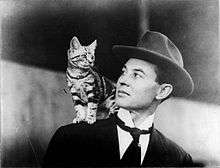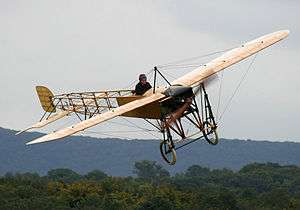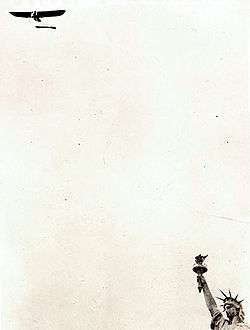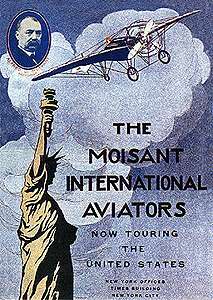John Moisant
| John Bevins Moisant | |
|---|---|
 Moisant and his cat, Mademoiselle Fifi, in 1910 | |
| Born |
April 25, 1868 Kankakee, Illinois, United States |
| Died |
December 31, 1910 (aged 42) Kenner, Louisiana, United States |
| Occupation | Aviator |
| Parent(s) |
Medore Moisant Josephine Fortier |
John Bevins Moisant (April 25, 1868 – December 31, 1910), known as the "King of Aviators," was an American aviator, aeronautical engineer, flight instructor, businessman, and revolutionary.[1][2][3][4] As a pilot, he was the first to conduct passenger flights over a city, across the English Channel, from Paris to London, in the state of Mississippi, and the co-founder of a prominent flying circus, the Moisant International Aviators.[5][6][7]
Moisant funded his aviation career with proceeds from business ventures in El Salvador, where he had led two failed revolutions and coup attempts against President Figueroa in 1907 and 1909.[8]
Early life
.jpg)
He was born in L'Erable, Illinois to Medore Moisant (1839-?) and Josephine Fortier (1841–1901).[9] Both parents were French-Canadian immigrants. His siblings include: George Moisant (1866–1927); Ann Marguerite Moisant (1877–1957); Matilde Moisant (1878–1964) who was the second American woman to receive her pilot's license; Alfred J. Moisant (c1862-1929); Louisa Josephine Moisant (1882–1957); and possibly Eunice Moisant (1890-?) who was born in Illinois. Alfred and Matilde were also aviators.[10]
In 1880 the family was living in Manteno, Illinois and Moisant's father was working as a farmer. In the mid-1880s, the family moved to San Francisco, California.[11]
El Salvador
He and his brothers moved to El Salvador in 1896 and bought sugarcane plantations that generated a substantial sum for the family. In 1909, José Santos Zelaya, president of Nicaragua asked John to go to France to investigate airplanes.
Aviation career
Early aeronautical engineering
John Moisant entered the aviation field in 1909 as a hobby after attending the Grande Semaine d'Aviation de la Champagne air show in Reims, France in August 1909.[12] He designed and built two aircraft between August 1909 and 1910, before he became an officially licensed pilot. His first was the Moisant Biplane, alternatively known as "L’Ecrevisse”, which he had built in Issy-les-Moulineaux, Paris, France.[13] This experimental aircraft, constructed by workers hired by Moisant from Clément-Bayard, became the first all-metal aircraft in the world, being constructed entirely from aluminum and steel. This aircraft was completed in February 1910; the Moisant biplane's inaugural flight, and Moisant first flight, ultimately resulted in a crash after ascending only 90 feet with limited airtime.[14][15]
Moisant's second project, begun in January 1910, resulted in the Moisant Monoplane, alternatively known as "Le Corbeau", which was partially built out of the wreckage of L’Ecrevisse.[16][17] The alternative design had difficultly staying upright on the ground and was never flown.[18][19]
Training in France
In the spring of 1910, Moisant took four flying lessons at the Blériot School, headed by Louis Blériot, in Pau, Pyrénées-Atlantiques, France, beginning his short but distinguished flying career.[20][21][22] Later, Moisant was granted a pilot's license from the Aéro-Club de France, which he transferred to the Aero Club of America to become the thirteenth registered pilot in the United States.[23]
Significant flights and aviation records

On August 9, 1910, Moisant flew his third flight as a pilot in his first recently purchased Blériot XI from Étampes to Issy-les-Moulineaux over Paris, landing the aircraft at the starting line of the Le Circuit de l'Est aerial time trial circuit.[24][25] Accompanying Moisant as a passenger on the flight was his mechanic, making the trip the first passenger flight over a city in the world.[26] At the time Moisant was still considered a novice pilot and had been previously denied entry into Le Circuit de l'Est competition by the Aéro-Club de France.[27] That same day, he followed this performance with an encore, flying over Paris again with Roland Garros, who would become a future member of the Moisant International Aviators flying circus, as his passenger.[28]
On August 17, 1910, he flew the first flight with a passenger across the English Channel. His passengers on the flight were Albert Fileux, his mechanic, and his cat, Mademoiselle Fifi. This feat was accomplished on Moisant's sixth flight as a pilot.[29]
Competitive events

At the Belmont International Aviation Tournament at Belmont Park, New York, John Moisant flew his Blériot XI around a marker balloon 10 miles (16 kilometers) away and returned to the racetrack in only 39 minutes, winning an $850 prize. After this initial competition, Moisant collided his brake-less Blériot into another aircraft while both were taxiing, causing it to flip over, but had repairs completed in time for the next event.[30] On October 30, 1910, at the same show, he competed in a race to fly around the Statue of Liberty. He won the race, beating Claude Grahame-White, a British aviator, by 42.75 seconds. However, he was later disqualified because officials ruled that he had started late. The $10,000 prize later went to Count Jacques de Lesseps not Grahame-White, because the latter had fouled during the race.[31]
On December 30, 1910, in New Orleans, he raced his Blériot XI five miles (eight kilometers) against a Packard automobile, but lost.[32][33]
| Year | Date | Competition name | Competition type | Location | Placing | Winnings | Description |
|---|---|---|---|---|---|---|---|
| 1910 | August 9–11 | Le Circuit de l'Est | Time Trial Circuit | Jarville-la-Malgrange, Meurthe-et-Moselle, Lorraine, France | DNC | 0 USD | Moisant's application to the competition was denied, as he had only completed two flights (one of which was in his own aircraft) at the time of the application.[34] |
| October 29 | Belmont International Aviation Tournament[35] | Time Trial Circuit, Gordon Bennett Cup | Belmont Park, New York | 2nd | 5,800 USD* | Finished with a time of 1 h 57 min 44.85 s | |
| October 30 | Air Race | DQ | Initially finished in first with a time of 34 minutes, 38.4 seconds.[36] *However, Moisant was later disqualified due to the failure to meet a rule that required one hour of flight time before the race.[37] | ||||
| October 31 | Distance Event | 1st | Completed 56 laps. | ||||
| December 31 | Michelin Cup[38] | Endurance Flight | City Park, New Orleans, Louisiana | DNS | 0 USD | Thrown from his plane while flying to the races starting point at Harahan. |
Entrepreneurship: the Moisant International Aviators

With his brother, Alfred Moisant, he formed the Moisant International Aviators, a flying circus which went barnstorming around the United States, Mexico, and Cuba.[39] Initially, John Moisant was one of the pilots in the exhibitions, along with Charles K. Hamilton, Rene Simon, Rene Barrier, J.J. Frisbie, C. Audemars, and Roland Garros.[40]
Death
.jpg)
Moisant died on December 31, 1910, in Kenner, Louisiana in an air crash while making a preparatory flight in his attempt to win the 1910 Michelin Cup and its $4,000 prize.[41] He was caught in a gust of wind as he was attempting to land and was thrown from his Blériot XI monoplane, landing on his head.[42] Fellow aviator Arch Hoxsey died the same day.
John Moisant was buried at the Valhalla Memorial Park Cemetery in Los Angeles, California. His body was later moved to the Portal of Folded Wings Shrine to Aviation, also in Los Angeles.
Legacy
"Nine-tenths confidence and one-tenth common sense equals [a] successful aviator."— John B. Moisant, How to Fly: The Flyer's Manual, 1917
John Moisant was one of the first to advocate for monoplanes with one set of fixed wings. Additionally, he believed in the potential of the use of aircraft in armed conflict.
Moisant Field
The international airport of New Orleans, Louisiana was originally named Moisant Field in his honor, though it has since been renamed Louis Armstrong New Orleans International Airport. The airport retains its "MSY" identifier, derived from the airport's origins as "Moisant Stock Yards" the name given to the land where Moisant's fatal airplane crash occurred, and upon which the airport was later built.
References
- ↑ Stoff, Joshua. 1996. Picture History of Early Aviation 1903-1913. P.72.
- ↑ Mortimer, Gavin. 2010. Chasing Icarus: The Seventeen Days in 1910 That Forever Changed American Aviation. P.58.
- ↑ McLean, Jacqueline. 2001. Women With Wings. P.23.
- ↑ American Aviation Historical Society Journal, Volumes 7-8.
- ↑ Caire, Vincent P. 2012. Louisiana Aviation: An Extraordinary History in Photographs.
- ↑ American Aviation Historical Society Journal. 1984. Volumes 29-30.
- ↑ Simmons, Thomas E. 2013. A Man Called Brown Condor: The Forgotten History of an African American Fighter Pilot.
- ↑ Mortimer, Gavin. 2010. Chasing Icarus: The Seventeen Days in 1910 That Forever Changed American Aviation P.59-62.
- ↑ "United States Census, 1880," index and images, FamilySearch (https://familysearch.org/pal:/MM9.1.1/MXVS-G6M : accessed 29 May 2013), John Moisant in entry for Medore Moisant, 1880.
- ↑ Caire, Vincent P. 2012. Louisiana Aviation: An Extraordinary History in Photographs.
- ↑ Mortimer, Gavin. 2010. Chasing Icarus: The Seventeen Days in 1910 That Forever Changed American Aviation P.59.
- ↑ http://siris-archives.si.edu/ipac20/ipac.jsp?uri=full=3100001~!228060!0. Accessed 26 May 2013.
- ↑ http://members.shaw.ca/flyingaces/br.pre1914/. Accessed 22 May 2013.
- ↑ Rich, Doris L. 1998. The Magnificent Moisants: Champions of Early Flight. P. 37–38.
- ↑ Flight. August 27, 1910. P. 692
- ↑ Villard, Henry S. 1987. Contact!: The Story of Early Aviators. P. 114–115.
- ↑ Rich, Doris L. 1998. The Magnificent Moisants: Champions of Early Flight. P. 38.
- ↑ Villard, Henry S. 1987. Contact!: The Story of Early Aviators. P. 115.
- ↑ Rich, Doris L. 1998. The Magnificent Moisants: Champions of Early Flight. P. 38.
- ↑ Rich, Doris L. 1998. The Magnificent Moisants: Champions of Early Flight. P. 39.
- ↑ http://airandspace.si.edu/research/arch/findaids/pdf/Moisant_Family_Scrapbooks_Finding_Aid.pdf. Accessed 26 May 2013.
- ↑ http://doversociety.homestead.com/flight.html. Accessed 26 May 2013.
- ↑ Rich, Doris. 1998. The Magnificent Moisants: Champions of Early Flight. P. 40.
- ↑ Hopkins, Jerry. 1960. King of the Aviators. http://www.airforcemag.com/MagazineArchive/Pages/1960/August%201960/0860moisant.aspx. Accessed 30 May 2013.
- ↑ Villard, Henry S. 1987. Contact!: The Story of Early Aviators. P.115.
- ↑ Hopkins, Jerry. 1960. King of the Aviators. http://www.airforcemag.com/MagazineArchive/Pages/1960/August%201960/0860moisant.aspx. Accessed 30 May 2013.
- ↑ http://www.airspacemag.com/history-of-flight/The-Daring-Mr-Moisant.html. Accessed 25 May 2013.
- ↑ Hopkins, Jerry. 1960. King of the Aviators. http://www.airforcemag.com/MagazineArchive/Pages/1960/August%201960/0860moisant.aspx. Accessed 30 May 2013.
- ↑ http://www.airspacemag.com/history-of-flight/The-Daring-Mr-Moisant.html. Accessed 25 May 2013.
- ↑ Joshua Stoff. Long Island aircraft crashes 1909-1959. p. 15.
- ↑ The New York Time. 15 March 1911.
- ↑ US Naval Institute. 1911. Proceedings. P.204.
- ↑ Simmons, Thomas E. 2013. A Man Called Brown Condor: The Forgotten History of an African American Fighter Pilot.
- ↑ http://jarvillehier.free.fr/articles.php?lng=fr&pg=77. Accessed 29 May 2013.
- ↑ The Chicago Daily News Almanac and Year Book for 1911. P.316.
- ↑ Shaw, Albert. 1910. The American Review of Reviews. P.662.
- ↑ Aeronautics. 1911. P. 218.
- ↑ Widmer, Mary L. 1993. New Orleans in the twenties. P. 110.
- ↑ http://www.earlyaviators.com/emoisjo1.htm. Accessed 26 May 2013.
- ↑ Aeronautics. December, 1910.
- ↑ http://www.nola.com/arts/index.ssf/2010/12/post_35.html. Accessed 22 May 2013.
- ↑ Bilstein, Roger E. 2001. Flight in America: From the Wrights to the Astronauts.
External links
| Wikimedia Commons has media related to John Moisant. |
| Wikimedia Commons has media related to Moisant aircraft. |
| Wikisource has original text related to this article: |
- Early Aviators: John Moisant
- Moisant Aviation
- Archive
- Doug McCash, "John Moisant, aviation pioneer, died a century ago in New Orleans", Times-Picayune, December 31, 2010.